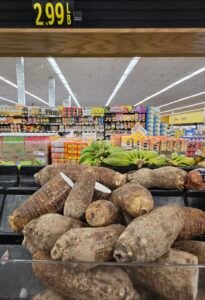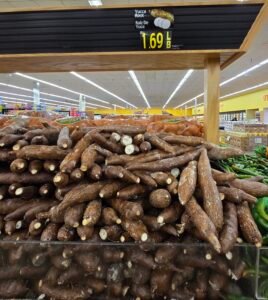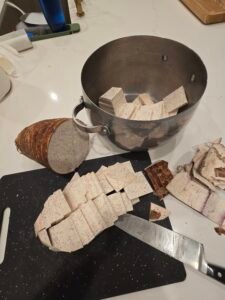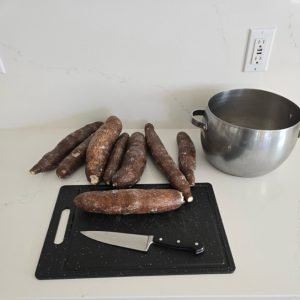
Yucca root, elephant taro root, malanga root, and tropical (name) yams are commonly found in ethnic supermarkets but not so much in national chains. It’s worth venturing out to find these roots, as they are used to make my favorite dipping chips and fries. These low-glycemic starches contain fiber and nutrients. However, they can be intimidating to work with until you try it. The yucca root looks like a tree branch. Look for roots with bright white flesh. Break off a small piece if you need to. Avoid roots with large black veins or mushy spots. A few thin veins are okay and will blanch out during preparation. It’s also true that yucca root contains cyanide. About 80% of the cyanide is in the bark, which is removed by peeling. However, a significant amount remains. I’ll present three ways to prepare yuca so that it is safe to eat: safe, safer, and safest. Most yuca in the USA is sweet yuca. There is a bitter variety that should never be eaten because the cyanide concentration is too high to be detoxified to a safe level.
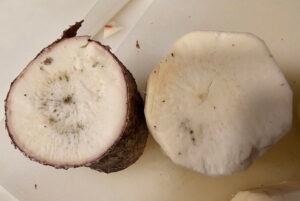
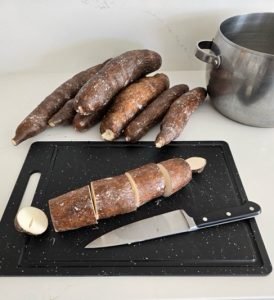
This is where you need a strong, thick knife. Cut across to make small logs, about 1–2 inches long. You can make them longer with more experience, but start out short.
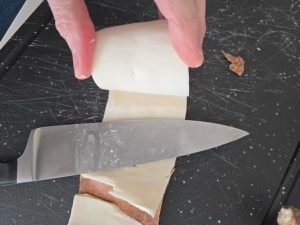
Gently groove the knife into the bark just enough to cut through it without going deeper into the flesh. Rock the blade sideways to split the bark off, then unroll it. You can judge the freshness of the root by how moist and easy it is to peel. Older roots do not peel as easily, but they are still good to use if the flesh is white. Older roots may need the bark shaved off. Keep your fingers clear, and use your sharpest knife.
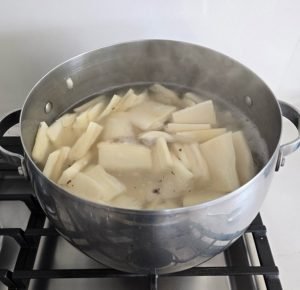
Now that all the chips are cut, rinse and drain them. Refill the pot and choose a method for cyanide detox.
The safe method is to soak for at least 20 minutes, drain, refill, and then continue to parboil.
For a safer method, soak for 24 to 48 hours with several changes of water. Then, continue to the parboiling step.
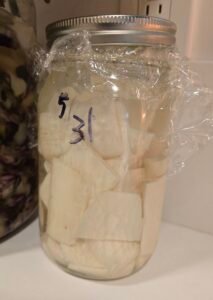
Safest Method: Place in a fermentation jar (the same type used for fermenting vegetables), cover with a 2% salt brine, and ferment for five days. The bacteria in the ferment will remove almost all of the cyanide. Then, proceed to the parboiling step.
For the parboiling step, add a little salt and bring to a simmer or low boil for at least 20 to 30 minutes. Ventilate the area and use a vent fan to safely remove the hydrogen cyanide gas.
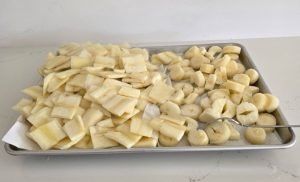
Once the chips are fork-tender, drain them and let them cool on a baking sheet. Arrange them on another sheet for freezing once cooled.
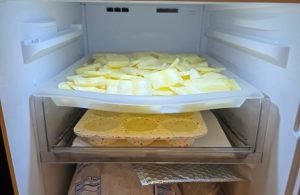
I like to stack them in an organized way to minimize them sticking together. Then, put them in the freezer overnight. The next day, bag them up in Ziploc bags. See the cooking section for preparation instructions.
It seems like a lot of work, and it is a process, but since I prepare about seven to nine pounds of yucca at a time, I don’t have to do it often. They are an absolute favorite in the house.
Yucca, malanga, elephant taro, tropical yams, and sweet potatoes can all be processed into tasty chips and fries. Compared to yucca, the others are much easier to peel. While they do not contain cyanide, they do contain oxalates. The best way to detoxify them is to pressure cook them instead of parboiling them. Cook them on high pressure for 6 minutes. Then, cool and freeze them.
Malanga is soft and slimy, yet it makes crunchy, delicious fries. Tropical yam fries, pronounced “nyam,” resemble baked corn puffs. Taro chips and fries are almost as crunchy as yucca and have a slightly fruity flavor. All of these options can be crispy on the outside when doused in olive oil and finished in an air fryer. For extra flavor, add a second soaking of olive oil for tropical yam fries.
